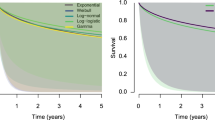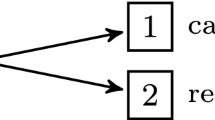Abstract
In meta-analysis of individual patient data with semi-competing risks, the joint frailty–copula model has been proposed, where frailty terms account for the between-study heterogeneity and copulas account for dependence between terminal and nonterminal event times. In the previous works, the baseline hazard functions in the joint frailty–copula model are estimated by the nonparametric model or the penalized spline model, which requires complex maximization schemes and resampling-based interval estimation. In this article, we propose the Weibull distribution for the baseline hazard functions under the joint frailty–copula model. We show that the Weibull model constitutes a conjugate model for the gamma frailty, leading to explicit expressions for the moments, survival functions, hazard functions, quantiles, and mean residual lifetimes. These results facilitate the parameter interpretation of prognostic inference. We propose a maximum likelihood estimation method and make our computer programs available in the R package, joint.Cox. We also show that the delta method is feasible to calculate interval estimates, which is a useful alternative to the resampling-based method. We conduct simulation studies to examine the accuracy of the proposed methods. Finally, we use the data on ovarian cancer patients to illustrate the proposed method.



Similar content being viewed by others
References
Belaghi RA, Asl MN (2019) Estimation based on progressively type-I hybrid censored data from the Burr XII distribution. Stat Pap 60(3):411–453
Burr IW (1942) Cumulative frequency functions. Ann Math Stat 13(2):215–232
Burzykowski T, Molenberghs G, Buyse M, Geys H, Renard D (2001) Validation of surrogate end points in multiple randomized clinical trials with failure time end points. Appl Stat 50(4):405–422
Chen YH (2012) Maximum likelihood analysis of semicompeting risks data with semiparametric regression models. Lifetime Data Anal 18:36–57
Duchateau L, Janssen P (2007) The frailty model. Springer, New York
Duchateau L, Janssen P, Lindsey P, Legrand C, Nguti R, Sylvester R (2002) The shared frailty model and the power for heterogeneity tests in multicenter trials. Comput Stat Data Anal 40(3):603–620
EL-Sagheer RM (2018) Estimation of parameters of Weibull–Gamma distribution based on progressively censored data. Stat Pap 59(2):725–757
Emura T (2019) joint.Cox: the joint frailty–copula models between tumour progression and death for meta-analysis, CRAN
Emura T, Nakatochi M, Murotani K, Rondeau V (2017) A joint frailty–copula model between tumour progression and death for meta-analysis. Stat Methods Med Res 26(6):2649–2666
Emura T, Nakatochi M, Matsui S, Michimae H, Rondeau V (2018) Personalized dynamic prediction of death according to tumour progression and high-dimensional genetic factors: meta-analysis with a joint model. Stat Methods Med Res 27(9):2842–2858
Emura T, Matsui S, Rondeau V (2019) Survival analysis with correlated endpoints, joint frailty–copula models. JSS research series in statistics. Springer, Singapore
Fine JP, Jiang H, Chappell R (2001) On semi-competing risks data. Biometrika 88(4):907–919
Ganzfried BF, Riester M, Haibe-Kains B, Risch T, Tyekucheva S, Jazic I, ... & Huttenhower C (2013) curatedOvarianData: clinically annotated data for the ovarian cancer transcriptome. Database. https://doi.org/10.1093/database/bat013
Lee KH, Haneuse S, Schrag D, Dominici F (2015) Bayesian semiparametric analysis of semicompeting risks data: investigating hospital readmission after a pancreatic cancer diagnosis. J R Stat Soc Ser C (Appl Stat) 64(2):253–273
Lee KH, Dominici F, Schrag D, Haneuse S (2016) Hierarchical models for semicompeting risks data with application to quality of end-of-life care for pancreatic cancer. J Am Stat Assoc 111(515):1075–1095
Li Z, Chinchilli VM, Wang M (2019) A Bayesian joint model of recurrent events and a terminal event. Biom J 60(1):187–202
Liu X (2012) Planning of accelerated life tests with dependent failure modes based on a gamma frailty model. Technometrics 54(4):398–409
MacDonald IL (2014) Does Newton–Raphson really fail? Stat Methods Med Res 23(3):308–311
Molenberghs G, Verbeke G, Efendi A, Braekers R, Demétrio CG (2015) A combined gamma frailty and normal random-effects model for repeated, overdispersed time-to-event data. Stat Methods Med Res 24(4):434–452
Nelsen RB (2006) An introduction to copulas, 2nd edn. Springer, New York
Peng M, Xiang L (2019) Joint regression analysis for survival data in the presence of two sets of semi-competing risks. Biom J. https://doi.org/10.1002/bimj.201800137
Peng M, Xiang L, Wang S (2018) Semiparametric regression analysis of clustered survival data with semi-competing risks. Comput Stat Data Anal 124:53–70
Rondeau V, Pignon JP, Michiels S, collaborative Group (2015) A joint model for the dependence between clustered times to tumour progression and deaths: a meta-analysis of chemotherapy in head and neck cancer. Stat Methods Med Res 24(6):711–729
Rotolo F, Legrand C, Van Keilegom I (2013) A simulation procedure based on copulas to generate clustered multi-state survival data. Comput Methods Programs Biomed 109(3):305–312
Rotolo F, Paoletti X, Michiels S (2018) surrosurv: An R package for the evaluation of failure time surrogate endpoints in individual patient data meta-analyses of randomized clinical trials. Comput Methods Programs Biomed 155:189–198
Schneider S, Demarqui FN, Colosimo EA, Mayrink VD (2019) An approach to model clustered survival data with dependent censoring. Biom J. https://doi.org/10.1002/bimj.201800391
Touraine C, Helmer C, Joly P (2016) Predictions in an illness-death model. Stat Methods Med Res 25(4):1452–1470
Vu HTV, Segal MR, Knuiman MW, James IR (2001) Asymptotic and small sample statistical properties of random frailty variance estimates for shared gamma frailty models. Commun Stat Simul 30:581–595
Weibull W (1951) Wide applicability. J Appl Mech 103(730):293–297
Acknowledgements
The authors kindly thank the associate editor and two anonymous referees for their valuable suggestions that improved the paper. We are grateful to Jia-Han Shih for his technical assistance for the data analysis and simulation studies. The research of Emura T is funded by the grant from the Ministry of Science and Technology of Taiwan (MOST, 107-2118-M-008 -003 -MY3).
Author information
Authors and Affiliations
Corresponding author
Additional information
Publisher's Note
Springer Nature remains neutral with regard to jurisdictional claims in published maps and institutional affiliations.
Electronic supplementary material
Below is the link to the electronic supplementary material.
Rights and permissions
About this article
Cite this article
Wu, BH., Michimae, H. & Emura, T. Meta-analysis of individual patient data with semi-competing risks under the Weibull joint frailty–copula model. Comput Stat 35, 1525–1552 (2020). https://doi.org/10.1007/s00180-020-00977-1
Received:
Accepted:
Published:
Issue Date:
DOI: https://doi.org/10.1007/s00180-020-00977-1




